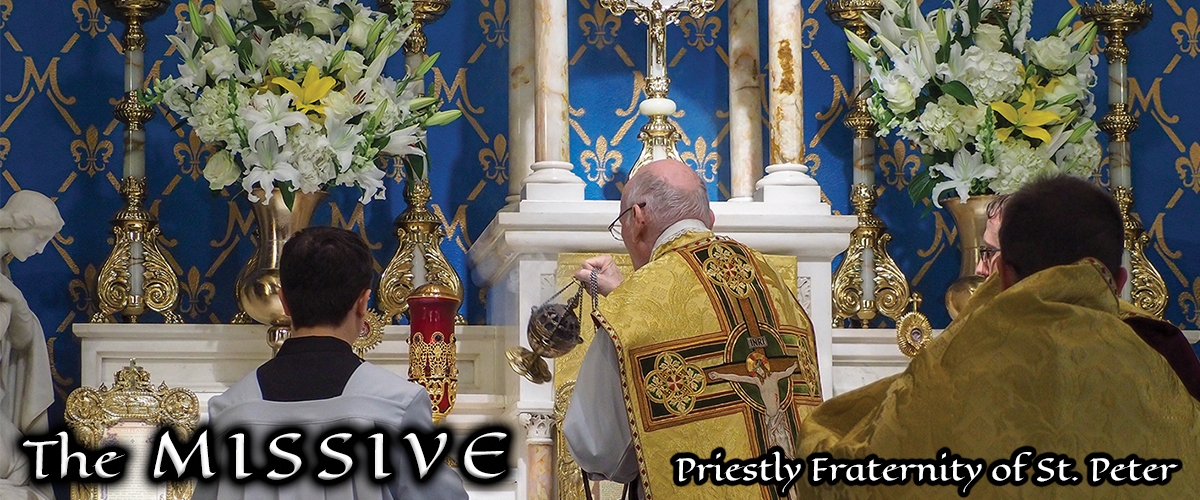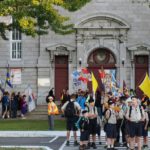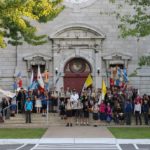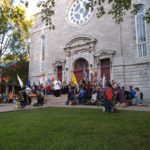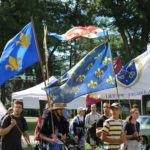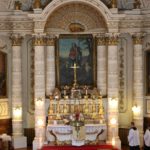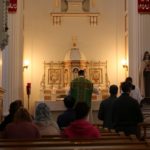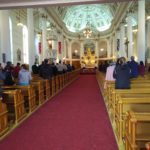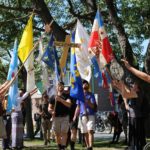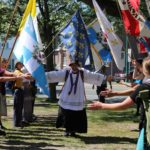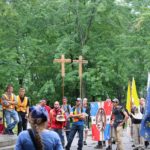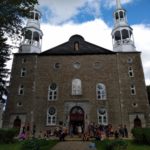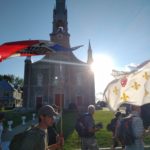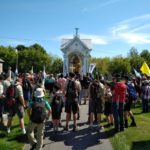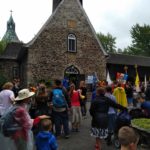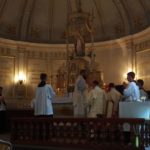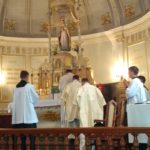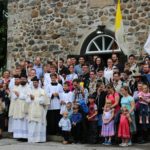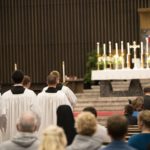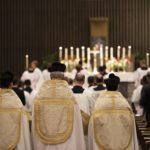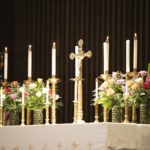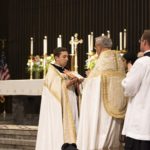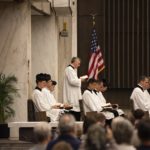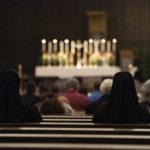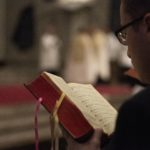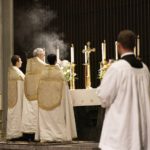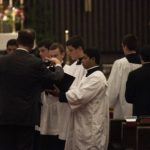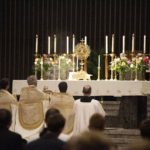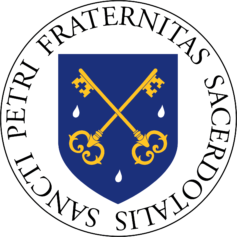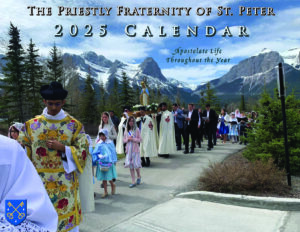A Journey to See the Queen
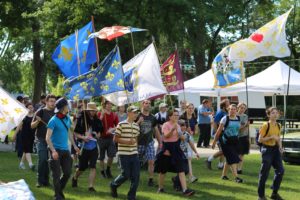 From August 31st – September 2nd, 2019, priests and parishioners from St. Clement Parish, our apostolate in Ottawa, Ontario, Canada, participated in the 16th annual pilgrimage to the shrine of Notre-Dame-du-Cap, Our Lady of the Cape, located in Cap-de-la-Madeleine, Québec. Marie Reine du Canada, a lay group based at St. Clement Parish, has organized the pilgrimage every year since 2003, when seven parishioners from St. Clement embarked on a pioneering pilgrimage to pave the way for the next group that would participate in larger numbers the next year, when it officially began.
From August 31st – September 2nd, 2019, priests and parishioners from St. Clement Parish, our apostolate in Ottawa, Ontario, Canada, participated in the 16th annual pilgrimage to the shrine of Notre-Dame-du-Cap, Our Lady of the Cape, located in Cap-de-la-Madeleine, Québec. Marie Reine du Canada, a lay group based at St. Clement Parish, has organized the pilgrimage every year since 2003, when seven parishioners from St. Clement embarked on a pioneering pilgrimage to pave the way for the next group that would participate in larger numbers the next year, when it officially began.
The chaplains this year were St. Clement assistant pastor Fr. Jacques Breton, FSSP and Fr. Peter Do, Diocese of Pembroke (neighbouring diocese to  the west of Ottawa). The parish has one English chapter, one French, one for the scouts from St. Clement Parish, and the St. Joseph Workers Chapter, with about 115 pilgrims total (including volunteer worker pilgrims) participating this year. Pilgrims come from all over North America – mostly Ottawa, Toronto and Montréal. This year one pilgrim flew in from British Columbia, and some came from Michigan, New Brunswick (home province of the recently ordained Fr. Luc Poirier) and Québec City. In years past, pilgrims have traveled from Manitoba, New York, Pennsylvania, California, Michigan and Washington.
the west of Ottawa). The parish has one English chapter, one French, one for the scouts from St. Clement Parish, and the St. Joseph Workers Chapter, with about 115 pilgrims total (including volunteer worker pilgrims) participating this year. Pilgrims come from all over North America – mostly Ottawa, Toronto and Montréal. This year one pilgrim flew in from British Columbia, and some came from Michigan, New Brunswick (home province of the recently ordained Fr. Luc Poirier) and Québec City. In years past, pilgrims have traveled from Manitoba, New York, Pennsylvania, California, Michigan and Washington.
 The pilgrimage is 100 kilometers or 62 miles in length (roughly the same as the Chartres pilgrimage). It begins in Lanoraie, Québec, which is approximately where St. Isaac Jogues was first captured by the Iroquois (in fact, pilgrims stop and pray near a monument marking this event). They walk “in the footsteps” of the North American Martyrs along the St. Lawrence River, attending Mass in beautiful old Quebecois churches and saying Compline together each night. Pilgrims walk only with small packs, while their luggage is transported by a large truck from campsite to campsite. Meals are simple: bread and peanut butter, nutella, jam, and coffee or hot chocolate for breakfast; bread for lunch; bread, soup and a little red wine for dinner.
The pilgrimage is 100 kilometers or 62 miles in length (roughly the same as the Chartres pilgrimage). It begins in Lanoraie, Québec, which is approximately where St. Isaac Jogues was first captured by the Iroquois (in fact, pilgrims stop and pray near a monument marking this event). They walk “in the footsteps” of the North American Martyrs along the St. Lawrence River, attending Mass in beautiful old Quebecois churches and saying Compline together each night. Pilgrims walk only with small packs, while their luggage is transported by a large truck from campsite to campsite. Meals are simple: bread and peanut butter, nutella, jam, and coffee or hot chocolate for breakfast; bread for lunch; bread, soup and a little red wine for dinner.
The closing Mass was a Solemn High Mass, celebrated by Fr. Do, assisted by Fr. Breton and Fr. Alex Marchand, FSSP, recently assigned to Québec City.
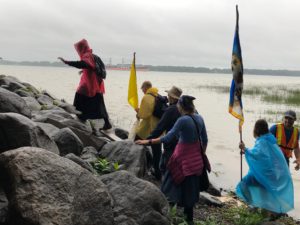 Our Lady of the Cape Shrine is Canada’s national shrine to Our Blessed Mother, and the old fieldstone church, the oldest church in Canada in which Mass is offered daily, was party to not one but two miracles in the later 19th century. When that church, dating from 1720, was becoming too small, the parishioners planned to construct a larger one with materials from across the St. Lawrence River, which usually froze over and offered a means to transport the materials. But that winter, the winter of 1879, was a mild one and the river did not freeze. The parishioners prayed the Rosary for the freezing of the river, and the pastor, Fr. Désilets, promised Our Lady that he would dedicate the fieldstone church to her instead of demolishing it if she interceded for them. In the middle of March, the ice came and as promised, the old church was dedicated to Our Lady on June 22nd, 1888 and a statue of her, formerly in an alcove, installed above the high altar.
Our Lady of the Cape Shrine is Canada’s national shrine to Our Blessed Mother, and the old fieldstone church, the oldest church in Canada in which Mass is offered daily, was party to not one but two miracles in the later 19th century. When that church, dating from 1720, was becoming too small, the parishioners planned to construct a larger one with materials from across the St. Lawrence River, which usually froze over and offered a means to transport the materials. But that winter, the winter of 1879, was a mild one and the river did not freeze. The parishioners prayed the Rosary for the freezing of the river, and the pastor, Fr. Désilets, promised Our Lady that he would dedicate the fieldstone church to her instead of demolishing it if she interceded for them. In the middle of March, the ice came and as promised, the old church was dedicated to Our Lady on June 22nd, 1888 and a statue of her, formerly in an alcove, installed above the high altar.
But an even more astonishing miracle occurred right then. On the evening of the day of the dedication, Fr. Désilets and 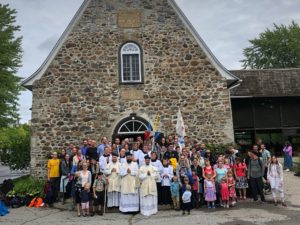 a Franciscan priest, Fr. Frédéric, were helping a lame man into the church so he could pray. While they were there, the three men witnessed the statue of Our Lady above the altar open her eyes. The statue normally has downcast eyes, but they saw her look up, her dark eyes wide open, for five to ten minutes. The statue who “opened her eyes” remains enthroned in the old stone church, Pope St. John Paul II visiting the miraculous statue in 1984.
a Franciscan priest, Fr. Frédéric, were helping a lame man into the church so he could pray. While they were there, the three men witnessed the statue of Our Lady above the altar open her eyes. The statue normally has downcast eyes, but they saw her look up, her dark eyes wide open, for five to ten minutes. The statue who “opened her eyes” remains enthroned in the old stone church, Pope St. John Paul II visiting the miraculous statue in 1984.
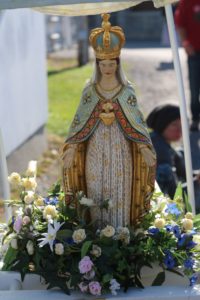 The pilgrimage is sure to continue next year, so join the parishioners of St. Clement if you are in the area round about the first weekend in September. There certainly does not seem to be a better way to spend the final days of summer than hiking along the beautiful St. Lawrence River, taking in the picturesque landscape of Québec and retracing the path of the North American Martyrs to pay a visit to the Reine du Canada, the Queen of Canada, at her chosen northern home. +
The pilgrimage is sure to continue next year, so join the parishioners of St. Clement if you are in the area round about the first weekend in September. There certainly does not seem to be a better way to spend the final days of summer than hiking along the beautiful St. Lawrence River, taking in the picturesque landscape of Québec and retracing the path of the North American Martyrs to pay a visit to the Reine du Canada, the Queen of Canada, at her chosen northern home. +
Our thanks to Ian Gallagher for his contributions to this article, and to Mr. Gallagher and Hannah Janek for their photos of the event.
In the Ask Father column of October’s Meménto, Fr. Dominic Savoie explains the nature and meaning of a pilgrimage. Read his article here!
October 10, 2019

Ask Father: October 2019
What is a pilgrimage? – Anne from Sacramento
Many years ago, I went on a pilgrimage. At the beginning of my journey, I knew what a pilgrimage was; but after 40 days, 600 miles, two mountain ranges, cities, vineyards, Roman roads and a rooster in a cathedral, I reached my destination and wasn’t too sure anymore. The whole adventure was a series of swings between chaos and serenity. I sort of knew where I was going. I met many fellow travelers on the road, who started walking from different places and took different routes, and all were going to the same destination. Or were we? Very few walked for the same reasons.
This made me wonder: What exactly is a pilgrimage? Can pilgrims walk to the same destination while the internal motivations which move their feet are as varied as: “to live simply,” “to lose weight,” “to recover from a bad relationship,” “to see the rooster”? These disparate intentions made me ponder the true nature of a pilgrimage. I’ve yet to fully understand it, but I offer you my thoughts thus far.
A pilgrimage is a three-part journey: a beginning, a path and an end. The beginning is not so important and is unique to each person. The path is also unique to each pilgrim but only at the outset, for as a pilgrim draws nearer the end his path will join others, and eventually all paths coalesce into a single point on the threshold. Ultimately, the destination is essential to a pilgrimage and separates it from all other trips man can make: it must be a sacred place, and the sacred points to something beyond the earth.
Since the dawn of time, when God “planted a garden,”[1] sacred space was defined. God is everywhere, yet in some places He dwells in a special, personal way. The heavens and the earth cannot contain Him and yet He was in Eden with Adam. The moment man lost that first sanctuary he began wandering through earth[2] with an unquenchable longing to regain Paradise, to return home. Though in exile, man was not completely lost, as the heavens continued to touch the earth at different times and places, and in those places man set up a marker stone[3] and removed his sandals.[4] This constitutes a sacred place. It’s a location where the firmament between Heaven and earth is porous. It’s the place of theophany, a dim echo of the first sacred place where God and man walked together[5]; for this reason man frequents sacred places and by returning to them continually attempts to return to God. All sacred edifices man constructs serve this purpose—to commune with God. All seek to remind man of his ultimate destination and to serve as extensions of Eden. If one enters a sacred building with any other intention, he is an intruder or a charlatan, a tourist or simply lost. In no way can one be a pilgrim without the dual destination in one’s mind—the sacred shrine and to be with the God it serves.
The pilgrim must make a journey, he must move himself to a destination and not simply change locations. The journey must cause sweat and it must be long, perhaps the longest walk of one’s life. This is because the pilgrimage is a living symbol of one’s whole life, it reminds us that we must walk towards the heavenly Jerusalem (probably for this reason the medieval clergy gave it as a penance). By walking to a sacred place, the true pilgrim hopes to walk through the earth and leave it behind.
To go on a journey is not unique to any man; all life is a journey. What is rare is to seek the true destination. Sadly, what is common to almost all is to find oneself lost along the way. Human art has always related this theme of the wandering man. From the opening line of the Odyssey: “Sing to me of the man, Muse, the man of twists and turns, driven time and again off course”[6] to that of the Inferno, “Midway along the journey of our life I woke to find myself in a dark wood, for I had wandered off from the straight path.”[7] Dante speaks for all of us, the journey of our life, and Homer ends his prologue with a similar perspective: “Launch out on his story, Muse, . . . sing for our time too.”[8] Man is on a journey through life, a homeless wandering vagrant, often ignorant of the path ahead and too weak to keep moving forward. But we can choose to be a pilgrim and not simply a vagrant, to acknowledge that we are “strangers and exiles on the earth . . . desiring a better country, a heavenly one” (Heb. 11:13-16). And there is no better way to run to Heaven than to focus one’s energies toward a heavenly destination on this earth, to deal with hardships, unknowns, lack of material goods, to progress down the right path, no matter the fatigue; literally, to subordinate all for the destination. To go on a pilgrimage is to practice what one must do throughout one’s whole life. +
Answered by:
Fr. Dominic Savoie, Assistant Pastor, FSSP Sacramento
- Genesis 2:8.
- Ibid. 4:12-14.
- Ibid. 28:10-22.
- Exodus 3:5.
- Genesis 3:8.
- Homer, trans. Robert Fagles, Odyssey, 1.
- Dante, trans. Marc Musa, Inferno, Canto 1.1.
- Odyssey, 1.11.
October 9, 2019

Happy Feast of Our Lady of the Rosary!
A happy and most glorious feast of Our Lady of the Rosary! This feast day has its origins in the famous victory at Lepanto on October 7th, 1571, when the Christian naval forces led by John of Austria defended Catholic Christendom from the invading Moslem Turks of the Ottoman Empire when the Rosary was prayed for victory. St. Pius V subsequently commanded that this feast, first called Our Lady of Victory, be kept on October 7th in commemoration of Our Lady’s intercession through her Most Holy Rosary.
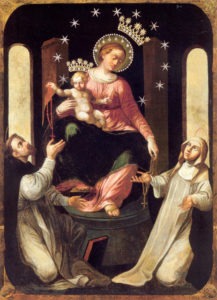
About this time last year, FSSP pilgrims visited the beautiful Pontifical Shrine of the Blessed Virgin of the Rosary of Pompei in Pompei, Italy. It was built by Blessed Bartolo Longo (1841-1926), a lawyer and former Satanic priest who became the “Apostle of the Rosary.” After his conversion, Blessed Bartolo still suffered from terrible guilt and depression in regards to his previous life, unable to escape the idea that he was still consecrated to Satan. He was in such despair that he contemplated suicide, but then he remembered the words of a Dominican priest who had been instrumental in his conversion, that anyone who propagated devotion to the Rosary would be saved. So for the rest of his life, that’s just what Bartolo did. He commissioned the Shrine after an image of Our Lady of the Rosary, first installed in a smaller church, proved to be miraculous, and the Bishop of Nola recommended he build a bigger church for it.
We too should cultivate devotion to the Rosary in ourselves and our families. Our Lady of Fatima asked us to recite it daily, so let us endeavor to obey her and offer her this devotion which is most pleasing to her. Our Lady of the Rosary, pray for us! +
October 7, 2019

OLGS Sings Solemn Vespers at Lincoln Cathedral
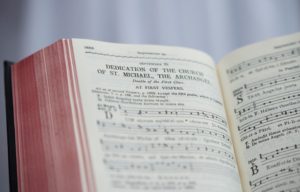 This past Sunday, the priests and seminarians of Our Lady of Guadalupe Seminary sang the Solemn Vespers of St. Michael the Archangel at the Cathedral of the Risen Christ in Lincoln, NE. Fr. Justin Wylie, the rector of the Cathedral, invited the Seminary to sing Vespers to begin the 40 Hours Devotion which the Cathedral held from September 29th through October 1st to commemorate their 60th year of Perpetual Adoration. 60 years of continual Adoration – what an extraordinary gift to God and a wonderful opportunity to celebrate with our friends at the Cathedral! +
This past Sunday, the priests and seminarians of Our Lady of Guadalupe Seminary sang the Solemn Vespers of St. Michael the Archangel at the Cathedral of the Risen Christ in Lincoln, NE. Fr. Justin Wylie, the rector of the Cathedral, invited the Seminary to sing Vespers to begin the 40 Hours Devotion which the Cathedral held from September 29th through October 1st to commemorate their 60th year of Perpetual Adoration. 60 years of continual Adoration – what an extraordinary gift to God and a wonderful opportunity to celebrate with our friends at the Cathedral! +
October 5, 2019

Angels in 5 Minutes
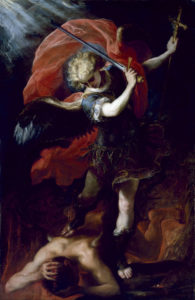
Happy feast of the Guardian Angels! In celebration of today’s feast, of St. Michael’s last Sunday and of St. Raphael’s which will arrive in 22 days, we challenged ourselves to create a bullet-pointed, handout-worthy, Facebookable version of two articles on angels by Dr. David Arias, professor of philosophy at Our Lady of Guadalupe Seminary. The consecutive articles, The Angelic Nature and The Understanding and Action of Angels, appeared in the September and October 2017 editions of Meménto, and gave a fascinating overview of who and what angels are, how their vastly superior minds work and what their role is in our own lives. Since you’re not a Catholic if you’re not an amateur (or professional) angelologist, we shall presume your interest in the subject matter. Here we go.
The Angelic Nature
- An angel is a created substance that is incorporeal and intellectual (St. Thomas Aquinas).
- Angels are persons, since everything with an intellect and a will is a person (Boethius).
- Although we’re both made in the image of God, angels differ from us insomuch as they are wholly incorporeal. Our souls are incorporeal, but the proper function of a soul is to inform a body, and hence it is not a complete substance without its body.
- Because they are immaterial, angels are naturally incorruptible.
- In addition, because, unlike us, they have no material as part of their nature (our bodies are created of material that can also be found in dogs, rivers, stars and other humans), they are irrepeatable. They are one-of-a-kind, possessing their nature so totally and completely as to exclude the possibility of another angel being of the same “species.” Each one is essentially unique.
The Angelic Mind
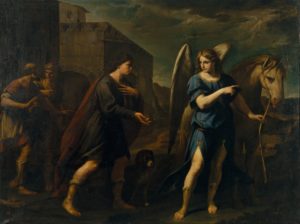
- Unlike us, angels have intrinsic and instantaneous knowledge of things. In order to form concepts of things, we have to first experience those things in our senses, then we can begin to understand their nature by considering what they have in common. Angels do not utilize this abstractive mode of thinking; they are infused with all the knowledge they need, and their knowledge of creatures includes knowledge both of a thing’s nature and of the particular examples of that nature. E.g., an angel with the knowledge of dogs understands the nature of a dog and Fido, Rex and Rover insomuch as they are possessors of the canine nature.
- Angels don’t reason. We humans move from a known concept to an unknown one using our reason, but angels’ knowledge is complete. An angel with the knowledge of triangles need not deduce that the sum of the angles of a triangle is always 180 degrees; he already knows everything there is to know about a triangle (if only, say the Euclidean geometry students).
- The angels bear a more perfect image of God than we do, due to their superior and more God-like intellect. Sorry, humans.
The Angels in Action
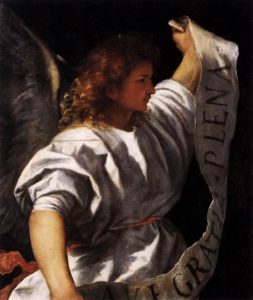
- Angels often put their angelic understanding of created things to work when they act in the natural world, as we see them do regularly in Scripture.
- Angels are teachers to us humans, and they do this in two ways, according to St. Thomas:
- They act on our interior sense powers (such as our imagination) to help us form mental images that help us to better understand things than we would on our own. They can also help us recall things that we already have in our intellect more easily (another tip for the geometry students).
- They unite their own intellectual understanding to ours to strengthen our intellect and help us perceive concepts better and more clearly. An analogy might be a pot of hot water (our intellect) that can heat pasta, but will do it an awful lot better with a fire underneath it (the angelic intellect).
And there you have it, angels in five minutes! Of course, there is much more to know about angels than we have room to discuss here, more, in fact, than we will have time to think about in this life, but fear not. The angels, and our Guardian Angels in particular, are fully invested in our salvation, and if we avail ourselves of their assistance and friendship, we can continue the conversation in Heaven. +
Angel of God, my guardian dear, to whom God’s love commits me here, ever this day be at my side, to light and guard, to rule and guide. Amen.
October 2, 2019

And You Visited Me
Where do you go next after running with the Saints? The City of Angels, of course. St. Vitus Parish, our apostolate in Los Angeles, was our destination after we took a reluctant leave of San Diego and headed north during the Missive’s 2019 California expedition, a tour of three apostolates that began in San Diego on July 26th and ended 500 miles away in Sacramento on August 5th. L.A. was our second stop.
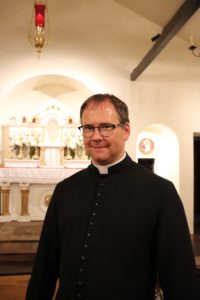
FSSP Los Angeles was founded in 2014 and is the fruit of several years of attempts to found an apostolate that had been stymied by the lack of an available Catholic church. In 2014, the FSSP asked if they could come and try to find an empty Protestant church to convert to the purpose, and Archbishop José Gomez granted permission. Fr. Fryar arrived and worked out of several temporary locations, primarily St. Victor’s in West Hollywood, before they at last found their own church in San Fernando in north Los Angeles. Archbishop Gomez dedicated the church of St. Vitus in June of last year and raised it to the rank of a parish.
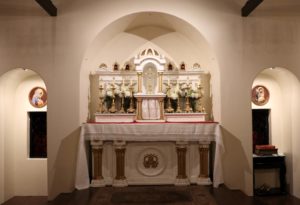
The only problem – if you can term it a problem – is that the parish has already outgrown the space, with indicators that the congregation would grow even more if they had more room. The church is full to overflowing four times a Sunday, with a total count of 400-450 (the church seats 120) after the priests saw the numbers double with the addition of the fourth Mass. For Holy Week this year, the parish set up a 500-person tent outside, with 400 people attending the Easter Vigil and around 700 over the week. But this is not an uncommon problem among Fraternity apostolates, and St. Vitus is approaching the issue as any other apostolate would: by raising money and getting a bigger church, hopefully by building one. They intend to stay in San Fernando, as it has proven to be a good part of the city for a number of reasons, among which is that it is amenable to most parishioners in terms of the infamous L.A. traffic (which is not to be trifled with; it can add 60+ minutes onto a trip during rush hour).
The music program at St. Vitus is particularly strong. The two choirs (one for each Sunday High Mass) are run by director Jeff Ostrowski, who had previously collaborated with the Fraternity to produce the St. Edmund Campion Missal & Hymnal, a common sight in Fraternity pews. The parish also hosts the annual Sacred Music Symposium, a week of training for choir directors and singers that takes place in June and features instruction from world-class musicians.
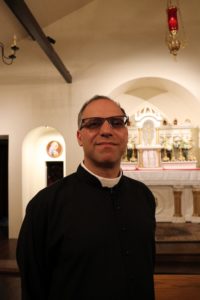
But perhaps the most thought-provoking ministry of our L.A. apostolate is its prison ministry, which, if most of us have perhaps heard the term, is not something we necessarily come into contact with on a daily basis. Fr. Federico Masutti, who is in his third year as assistant pastor, is priest-in-charge of the operation, which takes place at a large L.A. County state prison. He travels there regularly, primarily to offer the Sacrament of Confession to the inmates, and he has also celebrated the traditional Mass there several times. The ministry began when an inmate who had heard about the traditional Mass requested that a priest come to see him. Fr. Masutti considered it a good opportunity to assist with the needs of the Archdiocese; he said that it’s always good for the priests of the Fraternity to show that they can help with the priestly duties – such as hospital calls and chaplaincies – in the different dioceses where they are located.
There is a large Catholic population at the 5,000 person prison, said Fr. Masutti, but many are fallen away. He explained that a great need for prison ministry exists across the United States, as there is a scarcity of priests and the logistics are often difficult due to the remote location of most prisons. He considers it important to maintain a Catholic presence in the prisons, as many of the Catholics don’t have the opportunity to receive guidance and instruction in the Faith and there is a danger of them losing the Faith. But he says that there is much that can be done despite the difficulties, and even the parishioners at St. Vitus have lent their assistance by making rosaries and donating Catholic books for the prisoners.
Of course, a stereotype often comes to mind when we think of prisons, the images evoked involving, perhaps, maximum security facilities, dark halls, gangs, etc. But Fr. Masutti explained how his experiences at the L.A. prison dispelled those ideas, to the point that sometimes it’s easy to forget that you are in a prison facility. He recounted a memorable experience that occurred early on in his ministry. As he was preparing to hear Confessions in a classroom at the prison, one of the inmates simply smiled and said, “Good morning, Father.”
“From that moment on, everything changed in me,” said Fr. Masutti. “Everything disappeared when I saw that human element.”
Furthermore, he finds it moving to see how much the inmates desire to receive the Sacrament of Confession, and how happy they are to see a priest.
“It’s very rewarding spiritually,” he said.
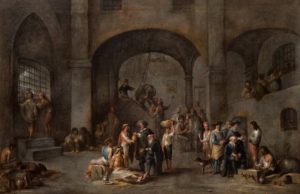
Fr. Masutti also addressed a question that probably arises in the minds of many of us when we consider how many young people end up in prison: Why are they here? These are people who are young and healthy. They are capable of working and have obvious talents: some take art classes at the prison and produce beautiful drawings. In a word, they have all kinds of potential, but instead of building successful lives for themselves, they somehow chose to go down a path that landed them in prison. Why? Fr. Masutti notes that many of them come from broken families.
“And that’s why family life is key,” said Fr. Masutti. “A government should protect the institution of the family, because most of those people there, I would say a very high percentage, they don’t have families . . . they are all broken families.”
He says that another problematic element of prison life is that, for the most part, these prisoners don’t get any visits, abandoned by those who know them on account of their crimes.
“They don’t get anything,” Fr. Masutti said with emphasis. “Because of the crimes that they committed before, a lot of people don’t [want to have] anything to do with them. But then it’s easy to forget. You don’t want to go to that environment, you don’t want to be there.”
He continued by quoting Matthew 25, where Our Lord speaks of the corporal works of mercy, among them, visiting the imprisoned. In that passage, Our Lord identifies Himself with the suffering and the imprisoned, saying that, when we visit them, we visit Him.
“All of us,” Fr. Masutti explained, “in one way or another, according to the circumstances that we have in life, we need to live those corporal works of mercy. Because those are the things in which Our Lord is going to judge us at the Last Day.”

Fr. Masutti mentioned that many saints, and even Our Lord Himself, were in prison. We were speaking to Fr. Masutti on August 1st; our final challenge to you is to go grab a pre-1960 missal and look up the old feast for that day. +
Then the righteous will answer Him, ‘Lord . . . when did we see thee sick or in prison and visit thee?’ And the King will answer them, ‘Truly, I say to you, as you did it to one of the least of these my brethren, you did it to me.’
– Matthew 25:37, 39-40
September 30, 2019

Happy Feast of the Dedication of St. Michael the Archangel!
A happy and most blessed feast of the great Archangel St. Michael! Today’s feast is of the first class; it therefore bumps the sixteenth Sunday after Pentecost to the commemoration spot, so important is St. Michael’s feast deemed by Holy Mother Church.
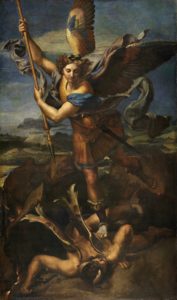
St. Michael is known to us as the prince of the angels and leader of the heavenly armies, and as such he is the great nemesis of Satan. The latter said, “I will not serve” and aspired to defeat God Himself; the very name of St. Michael, by contrast, means “Who is like God?” and he led the good angels in battle against Satan and the fallen angels, casting them out of Heaven forever. He is mentioned by name both in Sacred Scripture (the book of Daniel, the letter of Jude and Revelation) and in the Sacred Liturgy as well. Nearly always portrayed in battle array with a sword or spear in his hand and Satan under his feet, St. Michael is the stalwart defender of Christians against the attacks of the Devil and our constant help in our spiritual battles. He is invoked in the well-known prayer to St. Michael, which we say with the other Leonine prayers after Low Mass and which should be in our hearts frequently besides. Let us not take our angelic friends for granted, but rather let us call upon them always, especially St. Michael, his fellow Archangels and our Guardian Angels, whose feast we celebrate on Wednesday.
The cover photo shows the cavernous Sanctuary of St. Michael at Monte Sant’Angelo, Italy, a place famous for the apparitions of St. Michael that occurred there. The church, set in the recesses of a cave, was never consecrated by human hands, since the Archangel himself consecrated it by his presence.
We wish a happy patronal feast day to St. Michael the Archangel Parish, our apostolate in Scranton, Pennsylvania! They are celebrating with a Solemn High Mass and pancakes today! +
Deus, qui miro órdine, Angelórum ministéria hominúmque dispénsas: concéde propítius; ut, a quibus tibi ministrántibus in cœlo semper assístitur, ab his in terra vita nostra muniátur.
O God, Who hast constituted the services of Angels and of men in a wonderful order, mercifully grant, that they who ever stand before Thy face to do Thee service in Heaven, may also defend our life upon earth.
– the Collect for today
The Prayer to St. Michael
St. Michael the Archangel, defend us in battle, be our protection against the wickedness and snares of the Devil. May God rebuke him, we humbly pray, and do thou, O prince of the heavenly host, by the power of God, cast into Hell Satan and all the evil spirits that prowl about the world seeking the ruin of souls. Amen.
September 29, 2019

FSSP Guadalajara Hosts 2nd Annual Homeschool Conference
by Guetty Pérez Colín
From July 5th – 7th, 2019, the 2nd annual “Pillars of Education” Catholic Homeschool Conference was held in Guadalajara, Mexico. The event was organized by Sedes Sapientiae, the homeschool cooperative of the parish of San Pedro en Cadenas of the FSSP in Guadalajara. This year, the title of the event was “Classical Education and Catholic Tradition.”
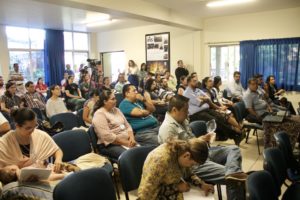 In total 166 people, 88 adults and 78 children, participated in the event from 10 different cities across Mexico. It was very inspiring to see so many large families gathered because of their commitment to give the best possible Catholic education to their children.
In total 166 people, 88 adults and 78 children, participated in the event from 10 different cities across Mexico. It was very inspiring to see so many large families gathered because of their commitment to give the best possible Catholic education to their children.
Unlike last year when the talks were directed primarily to those who already educate their children at home, this year the conference took a slightly different approach. Recognizing that parents must always be the primary educators of their children (whether they attend school or are educated at home), the organizers wanted to create an event of interest to all Catholic families. Therefore, this year’s conference sought to expound upon the rudiments of classical educational philosophy.
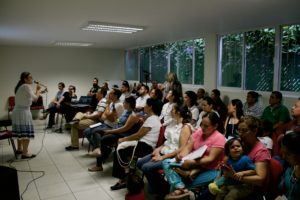 The classical method has been used for centuries, from the days of ancient Greek thinkers, through great saints such as Saint Thomas Aquinas, to the present day. The methodology helps teach the child to express, think, analyze and, finally, to communicate their ideas with well-developed arguments. It seeks to form human beings who do not just go with the flow, but rather who love and seek truth and beauty. And where there is real truth and beauty, there one always finds God.
The classical method has been used for centuries, from the days of ancient Greek thinkers, through great saints such as Saint Thomas Aquinas, to the present day. The methodology helps teach the child to express, think, analyze and, finally, to communicate their ideas with well-developed arguments. It seeks to form human beings who do not just go with the flow, but rather who love and seek truth and beauty. And where there is real truth and beauty, there one always finds God.
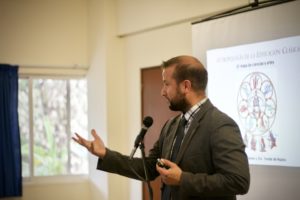 The event also made clear that Catholic tradition goes hand in hand with classical education. Both seek to instill reverence and an appreciation for truth and beauty. Both also have a long and proven track record. Knowing and living the tradition of the Church helps us to yearn for our own holiness and that of our children. Many participants in the conference experienced the traditional liturgy for the first time during these three days.
The event also made clear that Catholic tradition goes hand in hand with classical education. Both seek to instill reverence and an appreciation for truth and beauty. Both also have a long and proven track record. Knowing and living the tradition of the Church helps us to yearn for our own holiness and that of our children. Many participants in the conference experienced the traditional liturgy for the first time during these three days.
Some of this year’s conferences given by the priests and other guest presenters included:
“The Richness of Liturgical Tradition”
“What is a True Teacher?”
“The Essential Role of Art in the Formation of a Christian”
“The Trivium”
“Anthropology of Classical Education”
“How to Live According to a Rule of Life”
…among others.
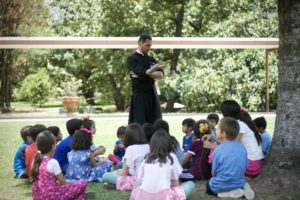 For the children there were also activities and themes during the event. There was an opportunity for them to receive formation, and also make new friends and play among themselves. Something very valuable for many families was the participation of the seminarians who were in Guadalajara participating in the Saint Junipero Serra Summer Spanish Institute. How important it is for the young to see their example! We hope some might be inspired to ask themselves if they too might have a vocation to give their lives to Christ for the salvation of souls.
For the children there were also activities and themes during the event. There was an opportunity for them to receive formation, and also make new friends and play among themselves. Something very valuable for many families was the participation of the seminarians who were in Guadalajara participating in the Saint Junipero Serra Summer Spanish Institute. How important it is for the young to see their example! We hope some might be inspired to ask themselves if they too might have a vocation to give their lives to Christ for the salvation of souls.
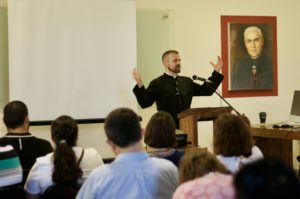 This year also included a day-long family retreat prior to the beginning of the conference, especially for those who came from outside the metropolitan area and do not have access to the Holy Mass in the traditional form. The families heard talks from Father Daniel Heenan, FSSP, pastor of the parish in Guadalajara. The theme was “Jesus, Eternal Wisdom.” There was time for meditation, prayer, confession and of course the Holy Mass.
This year also included a day-long family retreat prior to the beginning of the conference, especially for those who came from outside the metropolitan area and do not have access to the Holy Mass in the traditional form. The families heard talks from Father Daniel Heenan, FSSP, pastor of the parish in Guadalajara. The theme was “Jesus, Eternal Wisdom.” There was time for meditation, prayer, confession and of course the Holy Mass.
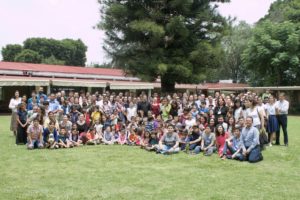 Next year the conference will run from August 2nd – 9th. The duration is being extended to one week since, in the first two years, the meeting has proven useful for families who educate at home, but also to promote the traditional Holy Mass, which is still very little known across Mexico and Latin America. The event will include a Gregorian chant and sacred art workshop, a pilgrimage for young adults, a theological colloquium and a day of recollection. Thanks be to God, families from Guadalajara have become members of the parish as a result of the conference and many who live elsewhere have gone home determined to work to bring the Latin Mass to their cities.
Next year the conference will run from August 2nd – 9th. The duration is being extended to one week since, in the first two years, the meeting has proven useful for families who educate at home, but also to promote the traditional Holy Mass, which is still very little known across Mexico and Latin America. The event will include a Gregorian chant and sacred art workshop, a pilgrimage for young adults, a theological colloquium and a day of recollection. Thanks be to God, families from Guadalajara have become members of the parish as a result of the conference and many who live elsewhere have gone home determined to work to bring the Latin Mass to their cities.
For more information about the conference and the apostolate of Sedes Sapientiae visit us on Facebook at www.facebook.com/SedesSapientiaeFSSP or write to us at sedes.fssp@gmail.com. +
September 24, 2019

Funeral Arrangements for Fr. Michael Irwin, FSSP
Please see the details below regarding the funeral arrangements for Fr. Michael Irwin, FSSP, who passed away earlier this week. All are welcome to attend.
The viewing, Rosary and funeral will be held at St. Thomas Catholic Church, located at 919 E. Indiana Ave., Coeur d’Alene, Idaho 83814.
The viewing will be from 5 – 7 p.m. on Wednesday, September 25th, with the Rosary at 7 p.m.
The funeral will be on Thursday, September 26th, at 10 a.m., with the interment to follow at Evergreen Cemetery, 2834 N. Spokane St., Post Falls, Idaho 83854.
In your charity, please continue to pray for the repose of Fr. Irwin’s soul. +
In paradísum dedúcant te Ángeli: in tuo advéntu suscípiant te Mártyres, et perdúcant te in civitátem sanctam Jerúsalem. Chorus Angelórum te suscípiat, et cum Lázaro quondam páupere ætérnam hábeas réquiem.
May the Angels lead thee into paradise: may the Martyrs receive thee at thy coming, and lead thee into the holy city of Jerusalem. May the choir of Angels receive thee, and mayest thou have eternal rest with Lazarus, who once was poor.
– the first Antiphon at the burial
September 21, 2019

September Ember Days This Week
Wednesday, Friday and Saturday of this week are the September Ember Days. Occurring once in each of the four seasons, the Ember Days are three days traditionally set aside for prayer and penance, the intention being to thank God for the gifts of Creation and to ask His help in using them well. Earlier this year, Fr. Arnaud Devillers, FSSP, wrote a fascinating piece that we published during the Lenten Ember Days about the history and significance behind this tradition, and we recommend it for your perusal again as we find ourselves already upon the Ember Days of autumn. Click here to read!
Sanábo contritiónes eórum, díligam eos spontánee: quia avérsus est furor meus ab eis. Ero quasi ros, Israël germinábit sicut lílium, et erúmpet radix ejus ut Líbani.
I will heal their breaches, I will love them freely; for My wrath is turned away from them. I will be as the dew: Israel shall spring as the lily, and his root shall shoot forth as that of Libanus.
Hosea 14:4-5, from the Epistle for Ember Friday
September 20, 2019

